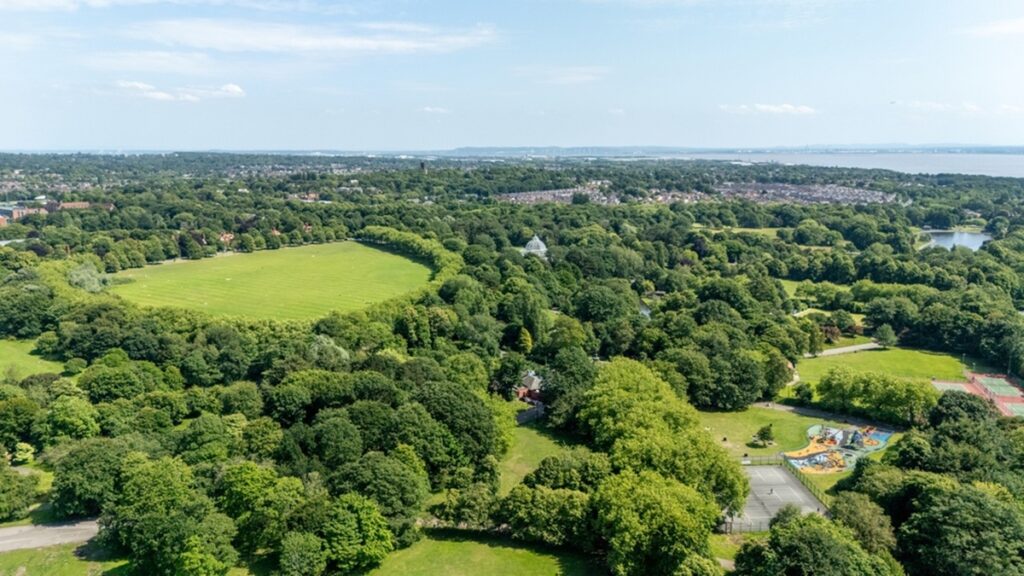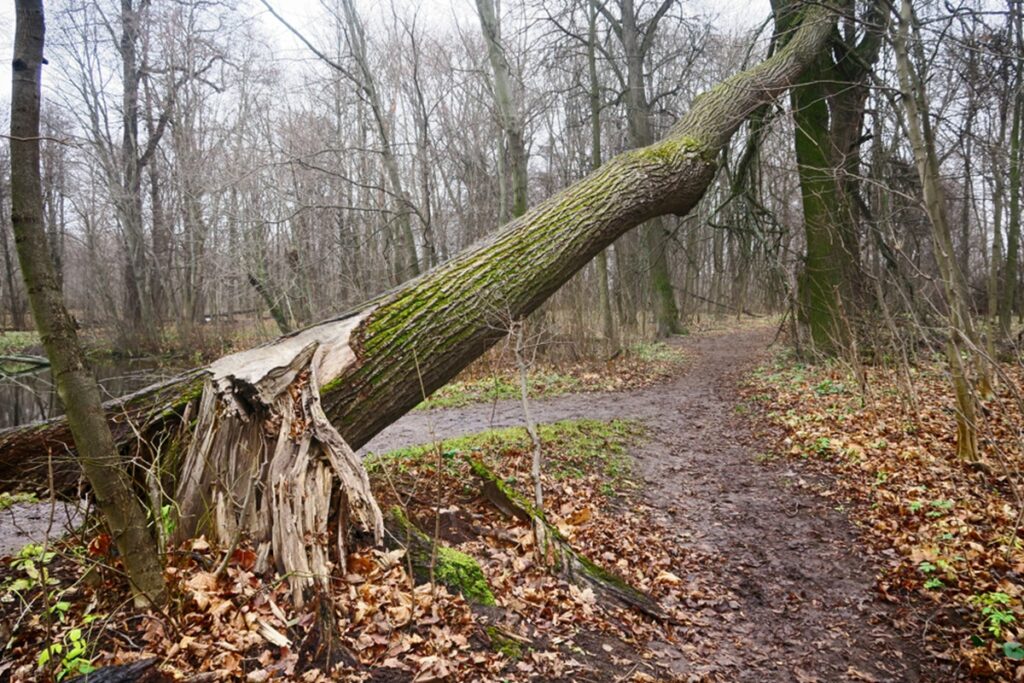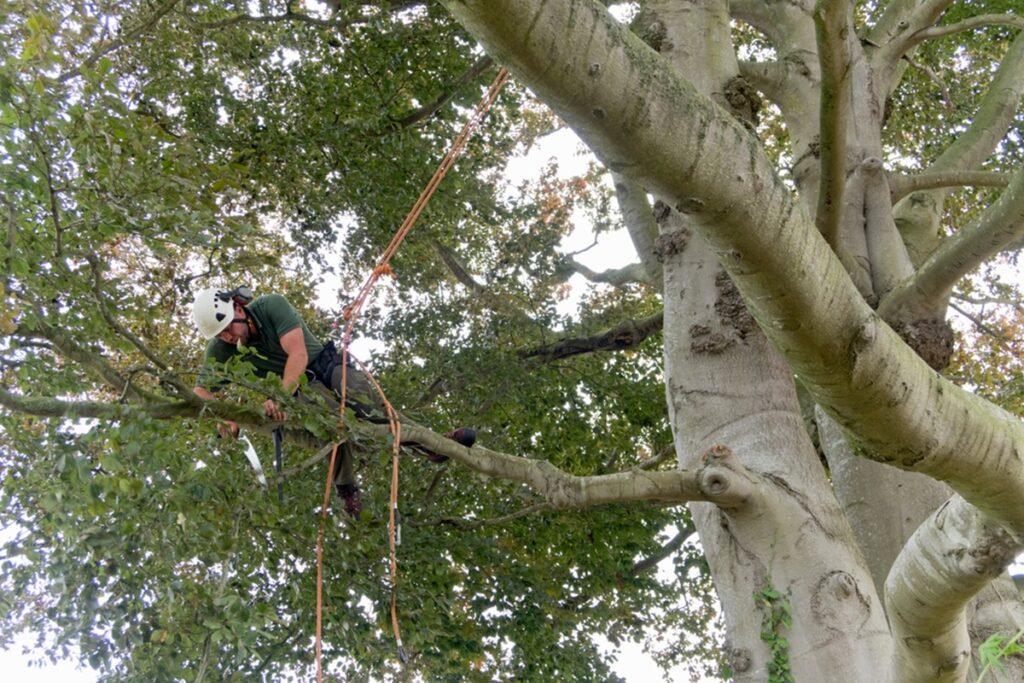Liverpool’s landscape and green assets
Liverpool is a city of remarkable contrasts – while being steeped in maritime heritage it is embracing ambitious urban renewal along the River Mersey and across its historic districts in the North West. With more than half a million residents and a built-up area extending across the riverfront, suburbs, and greenbelt landscapes, the city is recognised for its dedication to preserving urban tree cover. Tree-lined avenues, mature park woodlands, and coastal groves all combine to create Liverpool’s distinctive skyline.
As the city pursues extensive redevelopment, particularly around the Baltic Triangle, docklands, and suburban fringe, securing tree surveys has become essential for developers, housebuilders, landowners, and local authorities alike to enable sustainable development.

Liverpool’s Parks and Strategies to Protect Trees
Liverpool’s green assets are both iconic and diverse. Parks such as Sefton Park, with its Victorian planting and ancient oaks, Calderstones Park’s mix of woodland and botanical gardens, and riverside woodland corridors in Otterspool Park all act as vital habitats for bats, birds, invertebrates, and lichens. Beyond these flagship sites, mature street trees across Georgian terraces and post-war estates contribute to local quality of life and carbon sequestration. Liverpool City Council has committed to enhancing canopy cover, aligning with national climate strategies and biodiversity commitments. Trees that fall under Tree Preservation Orders (TPOs) or lie within designated Conservation Areas, including parts of the Georgian Quarter, Princes Park conservation areas, and the waterfront buffer, are subject to legal protections designed to ensure they are not altered or removed without appropriate assessment and consent.
As the Liverpool area evolves through regeneration and new construction, measures to protect trees take on dual significance: trees are valued both as natural capital and as planning constraints. Local planning authority policies require that any work near or on trees identified as TPOs, within Conservation Areas or prized assets such as Sefton Park, must be preceded by professional arboricultural surveys in Liverpool. Without tree surveys, a planning application may not even be validated.

Tree Surveys in the North West
The first step is the British Standard BS5837 tree survey, the industry-standard for examining the relationship between trees, design, demolition, and construction. These tree surveys ensure that visual inspections, measurements, and tree condition assessments are carried out comprehensively and consistently by arboricultural consultants.
Detailed Assessment
During BS5837 tree surveys, an experienced arboriculturalist makes a site visit to assess individual trees, including trees located in close proximity to the site boundary, especially where branches overhang the boundary, as well as any that may be affected by site activities or root disturbance. Each tree is surveyed for species, height, trunk diameter, branch spread, age, and health condition. Tree survey requirements include noting structural issues, fungal growth, root plate movement, or decay, and a separate assessment might be carried out if protected species or habitats are present. Arboricultural consultants then categorise trees by quality and retention value, ranging from high-value specimens essential to maintain through design, to low value or poor condition trees which might be included in removal plans if necessary.
Report Conclusions
The preference is always to retain trees wherever feasible. BS5837-compliant tree surveys help architects and designers shape the proposed layout, whether that involves adapting building footprints, shifting utility routes, or incorporating root protection zones to safeguard retained trees. When trees do need to be removed due to serious health or construction constraints, alternative mitigation strategies are explored, such as transplanting, replanting with native species, or integrating green infrastructure to ensure that this part of the landscape design is properly managed. Tree surgery recommendations may be contained in the report. Tree removal is treated as a last resort, subject to justification via the tree report.

The Tree Survey Report
Once survey work is completed, a structured arboricultural report is produced. This includes a tree constraints plan that clearly shows root protection areas overlaid on the site layout, along with a schedule of trees assessing retention value. In more complex projects, the tree report will be supported by an Arboricultural Impact Assessment, detailing how proposed works will impact retained trees, and an Arboricultural Method Statement, describing how site activities such as excavation, material storage, and scaffolding will be managed to avoid tree damage.
Arboricultural consultants may also produce a Tree Protection Plan, showing the location of protective fencing, access routes, and protective measures to be enforced throughout construction on the proposed development site. The completed tree survey report is submitted to the local planning authority to demonstrate that the development will take appropriate measures to protect trees in adherence to local tree policy and national standards, and can be used to support a planning application.

A Wide Range of Tree Surveys Beyond Planning
Schools, commercial properties, local authorities, social housing providers, and private landowners frequently commission tree condition assessments for health and safety compliance. With the city’s climate becoming increasingly prone to high winds and heavy rainfall, the risk of tree-related incidents such as branch failure makes regular inspections a practical necessity. These tree surveys and tree reports identify any action required to safeguard people and property; tree safety recommendations might include targeted pruning or emergency removal of boughs or unstable trees by tree surgeons.
Liverpool Council Strategy
Liverpool Council’s approach ensures that trees are properly managed, a stance that aligns with broader environmental priorities, including air quality improvement, stormwater management, pollinator habitat, and carbon sequestration. A holistic approach in the Liverpool area supports sustainable community growth while protecting the city’s green infrastructure. Whether you are submitting a planning application in Tree Preservation Order zones, working in a conservation area, or managing tree safety across public or private land in rural areas, professional tree surveys in Liverpool carried out by a reputable arboricultural consultancy will ensure compliance, reduce risk, and support better project outcomes.
Local Tree Surveys: Help Secure Planning Approval
Our arboricultural consultancy delivers expert local tree surveys and arboricultural reports in the Liverpool area, across the North West and the wider UK. Our tree consultants have extensive experience in local planning authority requirements and are Chartered Institute of Ecology and Environmental Management (CIEEM) affiliated; they can provide advice to ensure that your proposed development site can proceed through the planning process.
We work with developers, architects, landowners, housing associations, local authorities, and homeowners to provide impartial advice and clear, precise, policy-aligned tree surveys and reports geared to helping secure planning approval. Our qualified arboricultural consultants have many years experience in a wide range of tree surveys and arboricultural reports. Whether you need tree surveys in residential areas of Liverpool like West Derby or more rural areas in close proximity, we understand both Liverpool Council’s planning policies and the technical standards of BS5837, enabling smoother planning applications and reduced risk of delays or enforcement action. We also offer flexible appointments and rapid turnaround on quotes for arboricultural services to meet planning application timelines.
Request a Free Quotation for Local Tree Surveys
If you require tree surveys in Liverpool, contact us today. Call the number at the top of this page or complete our online enquiry form, and one of our specialists will arrange a suitable date for a site inspection. With the help of professional arboricultural consultants, your planning application could undergo a smooth journey through the planning process, with Liverpool’s trees safeguarded for successive generations.